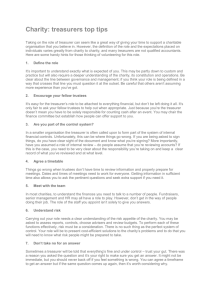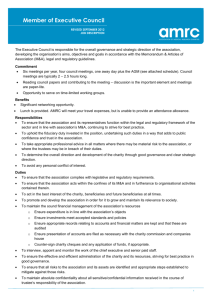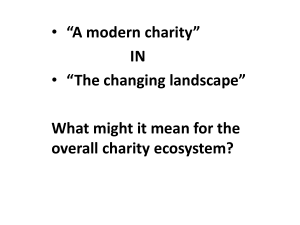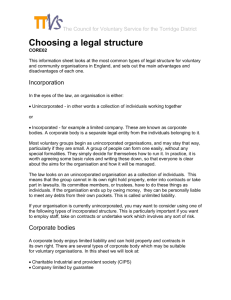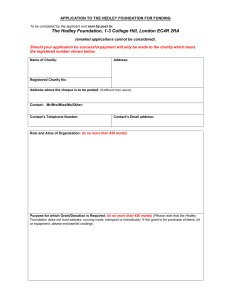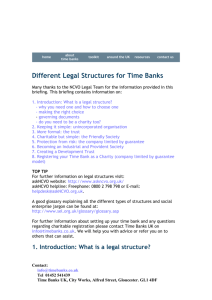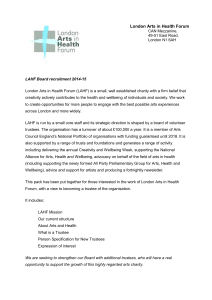What Alternatives Are There To Starting A Community Group
advertisement
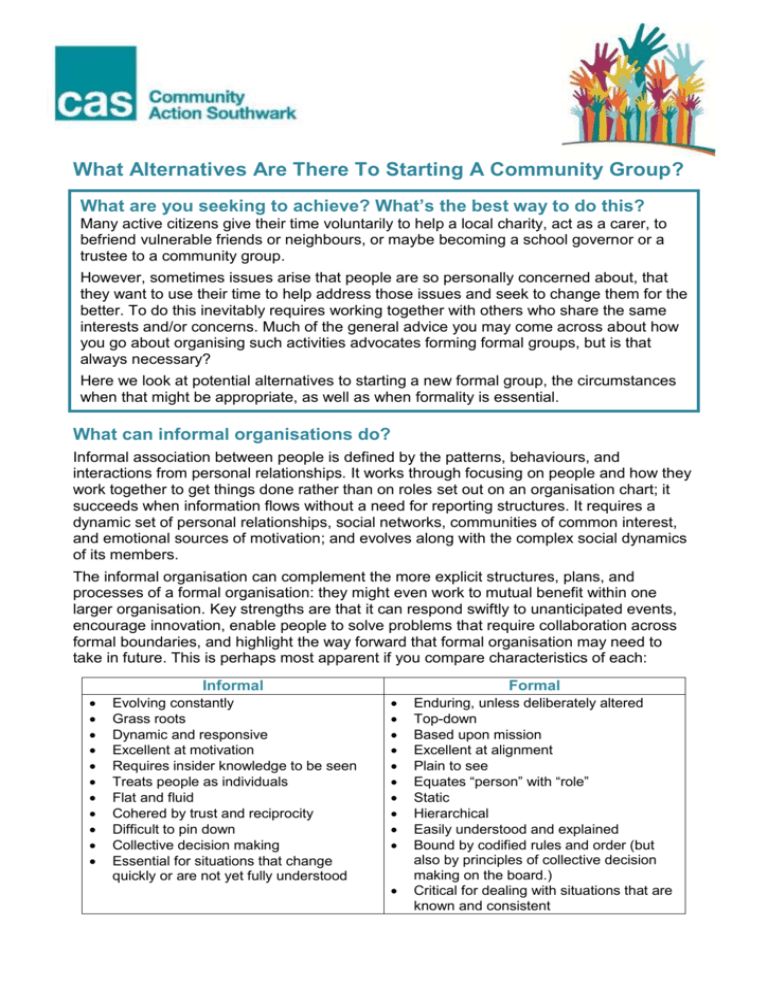
What Alternatives Are There To Starting A Community Group? What are you seeking to achieve? What’s the best way to do this? Many active citizens give their time voluntarily to help a local charity, act as a carer, to befriend vulnerable friends or neighbours, or maybe becoming a school governor or a trustee to a community group. However, sometimes issues arise that people are so personally concerned about, that they want to use their time to help address those issues and seek to change them for the better. To do this inevitably requires working together with others who share the same interests and/or concerns. Much of the general advice you may come across about how you go about organising such activities advocates forming formal groups, but is that always necessary? Here we look at potential alternatives to starting a new formal group, the circumstances thatsomeone might be appropriate, well asthis when formality is essential. Iswhen there out thereas doing already What can informal organisations do? Informal association between people is defined by the patterns, behaviours, and interactions from personal relationships. It works through focusing on people and how they work together to get things done rather than on roles set out on an organisation chart; it succeeds when information flows without a need for reporting structures. It requires a dynamic set of personal relationships, social networks, communities of common interest, and emotional sources of motivation; and evolves along with the complex social dynamics of its members. The informal organisation can complement the more explicit structures, plans, and processes of a formal organisation: they might even work to mutual benefit within one larger organisation. Key strengths are that it can respond swiftly to unanticipated events, encourage innovation, enable people to solve problems that require collaboration across formal boundaries, and highlight the way forward that formal organisation may need to take in future. This is perhaps most apparent if you compare characteristics of each: Informal Evolving constantly Grass roots Dynamic and responsive Excellent at motivation Requires insider knowledge to be seen Treats people as individuals Flat and fluid Cohered by trust and reciprocity Difficult to pin down Collective decision making Essential for situations that change quickly or are not yet fully understood Formal Enduring, unless deliberately altered Top-down Based upon mission Excellent at alignment Plain to see Equates “person” with “role” Static Hierarchical Easily understood and explained Bound by codified rules and order (but also by principles of collective decision making on the board.) Critical for dealing with situations that are known and consistent Do you really need a formal structure? Whilst the characteristics listed above might make informal a very appealing way to progress, unfortunately life is never as easy as that. There are some very important practical questions you need to consider, which may determine that formality becomes essential both to be able to achieve what you want, and to be able to access resources to enable you to do it. These might include: Is there an organisation already doing this? – If you don’t need to create something new, then don’t do it. Joining with others increases strength and voice, but still allows you to remain an informal group but collaborate with any number of organisations or networks. Is influencing and campaigning involved? – Organising local people to address issues of common local concern is one thing, but when issues are of much larger scale and require engaging with a much wider range of people and networks beyond the trusted social circle, defined roles and working methods increase in importance. Is this a time-limited issue? – Some issues can be addressed relatively quickly, and appropriate solutions found and implemented; but others will require long campaigns and/or developing longer-term working relationships if change is to happen and be sustained; in these instances a more formal structure could provide this continuity Will you provide services to people? – Engaging with others and sharing knowledge and information is very different from providing them with a service that helps them in their everyday lives; and with that comes an increasing level of legal obligations about how those services are provided and service users protected. How will you cover costs of the work? – Where you raise money from to cover running costs may determine your need to be formally organised. Some types of fundraising require you to have charity status, and some sources of grant funding can only fund registered charities. Even collecting membership fees from people begs that important question “membership of what?” THE ADVANTAGE OF FORMAL ORGANISATIONS Formal structures are easily understood, with clarity of who is in charge of whom, and who has responsibility for what. They operate through specific rules and regulations, which give little room for misinterpretation of processes and procedures; together with a clearly laid down information flow that ensures all levels have access to the information necessary to carry out their roles. One of the biggest complaints about formal structures is that layers of bureaucracy can slow down the decision-making process; whilst this is often true, more positively evidence is created that due diligence is applied when decisions are taken, which can be key to securing the trust of funders and other partners. WHAT FORM OF STRUCTURE? Even if you do need a formal structure, it is not always necessary for this to be complex. Your answers to the questions above might take you down the route to needing to be a registered charity, but there are other options; especially in your formative stages. See the CAS resource page on starting a group for more information on the structures below: http://casouthwark.org.uk/resources/starting-0 An unincorporated association – This is an organisation made up of a group of individuals, who have agreed to come together for a particular purpose: these are described as members of the association. It has a written constitution setting out how the association conducts its business, including how members are appointed (and removed) and how meetings are conducted. Decisions are usually taken by a management committee elected by the members. Being unincorporated, the association does not have limited liability, so the individual members involved are personally liable for any unmet debts. Community Action Southwark, 1 Addington Square, London SE5 0HF t: 020 7358 7020 f: 0845 305 2160 e: info@casouthwark.org.uk w: www.casouthwark.org.uk Registered Charity No. 1105835. Company limited by guarantee in England and Wales No. 5090324. VAT No. 948 4636 78 2 A trust - In the voluntary and community sector context a trust is created when a donor gives money or other assets (property, etc.) to a group of people (trustees) for use for a specified purpose, which has to be charitable. The agreement between donors and trustees is set out in a trust deed; which, similar to other unincorporated bodies, details how trustees are appointed and how meetings are conducted. A trust does not have members, but being unincorporated still does not have limited liability; and trustees are personally liable for unmet debts. (Different rules apply to how charitable trusts must operate compared to private family trusts.) Registered charity Choosing to register as a charity is a big step for those used to working together informally. Charities can be restricted on work they carry out, such as campaigning deemed to be political or some types of trading; similarly on how they are funded. They must comply with charity regulations, including providing annual accounts and other returns. (Charity Commission's website has more details https://www.gov.uk/topic/runningcharity/setting-up ). They cannot pay trustees without express permission from the Commission, in which case this must be stated in a charity’s constitution or governing document. This may not appeal to founders of organisations who want to receive a salary and retain control, as a founder who becomes a paid officer is an employee of the charity and can be dismissed by its board. Consequently founders usually sit on a charity’s board, unpaid, and sharing control and responsibility equally with other trustees. However, advantages of charitable status might still make it worthwhile, and include Public recognition and trust, widely recognised as a force for social good; Assets locked into the pursuit of charitable objectives, and not for private benefit; Relief from various taxes including business rates, and Recovering gift aid on donations; Access to wider range of grant and other funding sources. Further information and resources: For more on informal organisations http://casouthwark.org.uk/resources/starting-0 Comparing formal and informal structures http://smallbusiness.chron.com/basic-typesorganizational-structure-formal-informal-982.html and http://www.sociologyguide.com/organization-and-individual/differences.php Detailed guidance on setting up a charity https://www.gov.uk/topic/running-charity/settingup Information about the voluntary sector and starting up a group: http://knowhownonprofit.org/basics And you can find much more help, guidance and resources on starting up an organisation on our website …. http://casouthwark.org.uk/resources/starting-0 For further information, or to talk to us about why you might want to get more actively involved in your communities, contact the Volunteering and Engagement Team at CAS. 020 7358 7020, engage@casouthwark.org.uk Community Action Southwark, 1 Addington Square, London SE5 0HF t: 020 7358 7020 f: 0845 305 2160 e: info@casouthwark.org.uk w: www.casouthwark.org.uk Registered Charity No. 1105835. Company limited by guarantee in England and Wales No. 5090324. VAT No. 948 4636 78 3



